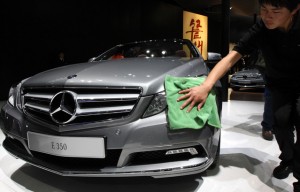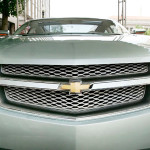 Daimler AG (DAI)’s Mercedes-Benz will introduce smaller luxury cars in India to attract middle-class consumers and close Bayerische Motoren Werke AG (BMW)’s widening lead in Asia’s second-fastest growing major economy.
Daimler AG (DAI)’s Mercedes-Benz will introduce smaller luxury cars in India to attract middle-class consumers and close Bayerische Motoren Werke AG (BMW)’s widening lead in Asia’s second-fastest growing major economy.
Mercedes, which lost the top premium sales post in India to BMW in 2009, plans to introduce cheaper models as early as 2013 to woo first-time luxury-car buyers in the country, Debashis Mitra, the division’s India sales chief, said in an interview.
The push follows BMW’s introduction of the locally assembled X1 compact sport-utility vehicle, now the Munich-based carmaker’s best-selling model in the country. Mercedes and BMW, which together control 70 percent of India’s luxury-vehicle segment, are fighting over a market forecast to almost triple to 47,000 vehicles by 2015, according to IHS Automotive.
“Better highways, higher disposable incomes and the growing aspirations of people in India will fuel growth in luxury-car sales,” said Rakesh Batra, head of Ernst & Young’s auto unit in New Delhi. “With the number of millionaires in India rising, the demand for luxury goodswill also increase.”
Stuttgart, Germany-based Mercedes delivered 6,753 vehicles in India in the year ended March 31. That compared with 7,079 cars by BMW, which aims to sell more than 10,000 autos in the country this year.
Part of the X1’s success is the lower sticker price. The model starts at 2.2 million rupees ($49,900) in New Delhi, less than half the 4.9 million-rupee sticker price for Mercedes’ cheapest SUV, the imported ML. The lowest-priced Mercedes, the C200 CGI Executive sedan, costs 2.58 million rupees.
Mercedes Assembly
Mercedes plans to assemble the new compact models, including small SUVs and sedans, locally from kits to lower the cost, Mitra said. Carmakers only pay a 10 percent duty on cars built in India instead of as much as 100 percent on imports. Mercedes produces the C-, E- and S-Class sedans in the country.
The increased presence may help Mercedes stem a plunge in market share. It controlled about 60 percent of India’s luxury market before BMW arrived in 2007, according to industry researcher IHS Automotive. That declined to 34 percent in 2010, with BMW accounting for 36 percent. Volkswagen AG (VOW)’s Audi brand is third with 17 percent, IHS data show.
To maintain its lead, BMW will introduce the larger X3 SUV in India this year as a locally assembled product, and expand capacity at its Chennai factory next year, said Andreas Schaaf, head of BMW’s India operations, adding that the country will be among BMW’s top 10 markets by 2020.
Dealer Growth
BMW will also more than double the number of dealers in India to 60 from 27 by the end of 2013, Schaaf said. Daimler plans to add as many as 15 dealerships and service centers a year nationwide. Mercedes, which has 36 showrooms and service centers in the country, wants to expand in secondary locations to tap potential for customers trading up to entry-level luxury vehicles from autos built by volume producers, Mitra said.
“Once a buyer buys an X1 or a Mercedes C-Class, the manufacturer can be assured that his next car will be a luxury car,” said Deepesh Rathore, India chief at IHS Automotive. “Even if the margins are lower in the entry-level segment, the manufacturer has a buyer for life.”
Premium cars account for less than 1 percent of total auto sales in India, according to Society of Indian Automobile Manufacturers data, meaning luxury-car makers have room for growth. Luxury car sales account for about 8 percent of the total market in Japan and 6 percent in South Korea, Schaaf said.
India’s central bank forecasts the economy will expand 8 percent in the current fiscal year, second only in the region to China, the world’s largest auto market.
Fading Taboo
“Buying a luxury car earlier was a taboo in India,” Mitra said in an interview at Mercedes’ factory in Pune in the western state of Maharashtra. “The earlier perception was rich people are bad people. That taboo is slowly, slowly going out.”
Still, the demand for cars is threatened by the highest borrowing costs since 2008 in a country where Brics Securities Ltd. of Mumbai says about 80 percent of all purchases are funded by loans. The Reserve Bank of India said Aug. 1 that rate increases are needed to restrain inflation after raising the benchmark repurchase rate five times in 2011. Auto sales grew 1.6 percent in June, the slowest pace in more than two years.
BMW, which currently can produce 10,000 cars a year in India, takes a long-term view. The carmaker aims to maintain market share of between 30 percent and 40 percent to 2020, when India’s premium-car market will grow to 150,000 vehicles annually from 17,814 in the year ended March 31, Schaaf said.
“The X1 is a major pillar for us and it brings new people to the brand,” Schaaf said in a July 26 interview in Gurgaon, near New Delhi. “We know that competition will flow into this segment but we have the first-mover advantage.”
The Mercedes initiative aims to counter BMW’s current edge.
“India will be one of the most important markets for automobiles,” Mitra said. “All our activities today that we’re driving toward are to see how we make the brand younger and more appealing.”










